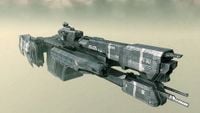UNSC frigate
From Halopedia, the Halo wiki
The UNSC Frigate is a starship classification in the UNSC fleet. Although it is significantly weaker in armor and armament compared to its larger cousin, the UNSC Destroyer, the frigate is smaller and thus more maneuverable. It is cheaper to produce, allowing greater numbers to be fielded against the Covenant. It is important to note that there is probably more than one class of UNSC Frigate.
Background
With current human technology, the UNSC frigate is barely a match for even the smallest Covenant vessel. It is outrun by even larger Covenant vessels, its armor susceptible to enemy pulse lasers, plasma torpedoes and its weaponry substandard. Only en masse does the UNSC frigate give any United Nations Space Command fleet element an advantage in the war against the genocidal Covenant.
Layout
The bridge of the frigate is located in the uppermost part of the ship, in the section at the stern-most tip of the mac gun shaft (in the case of the only seen version of the UNSC frigate, their is another layout variation similar in appearance to the UNSC Halcyon-class Cruiser Pillar of Autumn). The CO's chair is located behind the two primary consoles within the bridge, which in turn are located in front of a large window which gives a view of space. There are numerous other consoles located at the sides of the room. According to Halo: Fall of Reach, there are four stations for lieutenants: Navigation, Operations, Weapons, and Communications.
UNSC Frigates also possess at least one HEV Bay which facilitates the deployment of ODSTs.
As demonstrated in Halo 2 and 3, UNSC Frigates (specifically the Forward Unto Dawn and In Amber Clad) are capable of hovering in an atmosphere, and possibly landing. They also have either a garage or cargo bay in their rear section which is capable of extending out of the ship's ventral side to deploy vehicles or cargo directly to the ground.
Specifications
Dimensions
A typical frigate appears to be around 478 metres (1568 ft) long, 151 metres (498 ft) wide and 112 metres (396 ft) tall. It is one of the smallest UNSC capital ships seen so far in the Halo universe.
Propulsion
Like other human ships, the UNSC frigate is equipped with at least one nuclear reactor which initiates the process of fusion on deuterium fuel. The reactor then channels the output into exhausts at the vessel's rear. There are four exhausts visible on the craft, two large and two small. For translight speeds, the frigate carries a Shaw-Fujikawa slipspace drive. There are also probably multiple manouvering thrusters to adjust the vessel's attitude in pitch, roll and yaw. Lastly, frigates are equipped with vertical engines which allow it to hover in an atmosphere; an advantage of its small size and mass.
Armament
From examining various cutscenes, information from the novels and using the Camera out of Sandtrap glitch, one can piece together the armament of a typical frigate.
- 1 MAC Cannon which would require one charge per shot and store around six rounds.
- 3 Shiva Nuclear Missiles which would function as the ship's heavy nuclear ordnance.
- 26 Archer Pods which would carry around thirty missiles in each pod, adding up to a total of 780 total missiles. They can be seen dotted across the hull in Halo 3.
- 8 50mm Point-Defense Autocannons which would function as the last line of defense against incoming missiles or single ships. They are visible in several cutscenes and using the Camera out of Sandtrap glitch.
- several mounted Spartan lasers as in the level the Ark, they fire at you if you betray marines.
Crew
No precise figures are available regarding the crew of a frigate, but it is likely relatively small. Like larger ships, at least one battalion of conventional marines and sometimes ODSTs were also carried by the ships. The crew number includes deck crews, as well as the command crew, marines, ODST's, Longsword and Pelican Pilots, and technical personnel.
Superstructure
The armor of a frigate is poor compared to that of its larger cousins such as the UNSC Destroyer with just 60cm of battleplate, but because of its relatively light weight (4000 tons), the frigate's strength is instead in maneuverability and speed. It should be noted that there are multiple classifications of frigates, as mentioned once that the In Amber Clad was called a 'Heavy Frigate' which could specify that there are Light, Medium, Heavy and more Frigate Classifications that could have more or less armor, also that over the decades that the war has gone on, frigates needed refits and they could have been given more armor overtime.
Ships of the Line
Images
UNSC Aegis Fate (FFG-307)
UNSC In Amber Clad (FFG-142)
- New frigate.jpg
UNSC Forward Unto Dawn (FFG-201)


